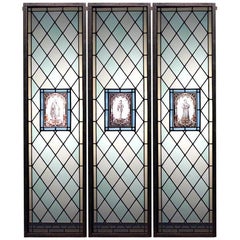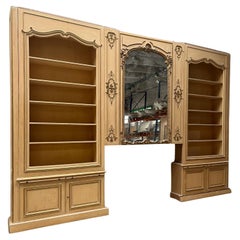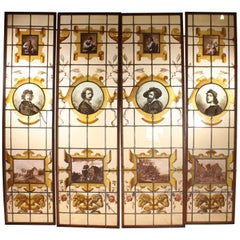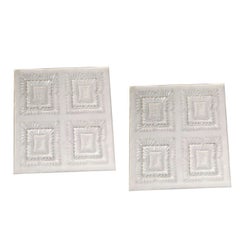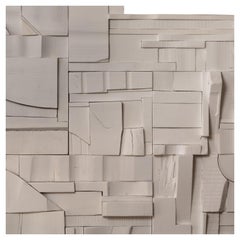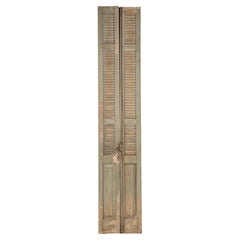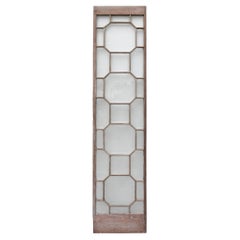Glass Panelling
to
2
9
6
14
4
Height
to
Width
to
3
2
1
1
1
4
10
4
2
5
1
1
2
2
152,738
219
72
37
36
12
7
2
2
2
18
15
15
1
1
1
Material: Glass
Set of 3 English Renaissance Leaded Glass Windows
Located in Queens, NY
Set of 3 English Renaissance style (19th Century) leaded glass window panels with diamond design and figure in center (PRICED AS SET).
Category
19th Century English Renaissance Antique Glass Panelling
Materials
Wood, Glass
$16,500 / set
Art Nouveau mahogany woodwork from Café Barjot in Paris, 1905
Located in SAINT-OUEN-SUR-SEINE, FR
This woodwork characteristic of the Art Nouveau style comes from the Café Barjot located avenue Ledru-Rollin in the 12th district of Paris, it was made in 1905. It is composed on a f...
Category
Early 20th Century French Art Nouveau Glass Panelling
Materials
Wood, Mahogany, Stained Glass
Grand Louis XV Style Boiserie Library with Mirror, France, 20th Century
Located in TOURCOING, FR
Grand Louis XV Style Boiserie Library with Mirror, France, circa 1950
This monumental Louis XV style boiserie library is an exceptional statement piece that combines refined French ...
Category
1950s Vintage Glass Panelling
Materials
Mirror, Wood
Solid Wood Panel in White and Ebony Finishing with Lalique Glass, Custom Made
By Alexander's Collection, Alexander Anisimov
Located in Hong Kong, HK
Solid Wood Panel in White and Ebony Finishing with Lalique Glass, Custom Made
Made of solid wood, painted, hand carved floral elements fixed on the panel by ...
Category
2010s Hong Kong Neoclassical Revival Glass Panelling
Materials
Plywood, Wood, Art Glass, Paint, Ebony, Mirror
$10,600 Sale Price / item
20% Off
4 Stained Glass of Painter of the Flemish Renaissance and Their Painting
Located in Brussels, Brussels
- Magnificent set of 4 windows of the 19th century representing the great painters of the Flemish Renaissance.
At the top of each stained-glass window are men playing guitar, smokin...
Category
19th Century Belgian Renaissance Antique Glass Panelling
Materials
Glass
R. Lalique Architectural Panels from the Oviatt Building
By René Lalique
Located in Bridgewater, CT
Pair of architectural panels from the elevator doors, Oviatt Building Los Angeles, 1927. In clear and frosted glass, 16 in. square.
Referenced in F....
Category
1930s French Art Deco Vintage Glass Panelling
Materials
Glass
Early 20th century French Glass and Fabric Folding Screen, 1920s
Located in LEGNY, FR
Add a touch of elegance and vintage charm to your interior with this stunning three-panel screen.
Perfect for dividing spaces in a living room, bedroom, or office, creating a cozy no...
Category
1920s French Vintage Glass Panelling
Materials
Fabric, Glass, Wood
Pair of Large 1940's French Black and Gilt Screens 'Paravent' with Glass Panels
Located in New York, NY
Pair of large 1940's French black and gilt room hinged screens or room dividers (Paravent) with beveled glass panels. The screens can be attached to crea...
Category
Mid-20th Century French Glass Panelling
Materials
Glass, Wood
Round Room with Shagreen Wallpaper
By Emilio Terry
Located in SAINT-OUEN-SUR-SEINE, FR
This round piece made at the end of the 20th century comes from a Parisian mansion. Its decoration is inspired by the work of the Franco-cuban decorator Emilio Terry (1890 -1869). Th...
Category
20th Century French Art Deco Glass Panelling
Materials
Alpaca, Mirror, Beech, Plywood, Paper
Spectra Dichroic Blinds, Rona Koblenz
Located in Geneve, CH
Spectra dichroic blinds, Rona Koblenz
Dimensions: W 108, D 5, H 203 cm
Material: Dichroic Borosilicate glass 6mm, SS cable, SS fixings
Weight: 35/50KG
Fixing methode: Hanging
De...
Category
2010s English Modern Glass Panelling
Materials
Glass
$28,564 / item
19th C Italian White and Gold Religious Stained Glass Church Panel
Located in Hastings, GB
A very beautiful carved wooden stained glass panel, highly decorative with water gilding and stained glass panelling.
Dating to the early 19th century, Italy, the panel has eight...
Category
1830s Italian Baroque Antique Glass Panelling
Materials
Gesso, Stained Glass, Wood
Two French Art Deco Architectural Etched Glass Cloud Panels
Located in New York City, NY
Two acid etched frosted glass architectural panels from the Art Deco period. The cloud and bird motif drift across the scene while the highly stylized foliate motif on the border ser...
Category
20th Century French Art Deco Glass Panelling
Materials
Art Glass
Vintage Regency Framed Quilt Panel
Located in West Palm Beach, FL
Add a touch of serene, handcrafted artistry to your walls with this stunning framed quilt panel. This exceptional piece of textile art showcases the incre...
Category
Late 20th Century American Folk Art Glass Panelling
Materials
Cotton, Glass, Wood
Biombo - Room Divider
Located in Ciudad de México, CDMX
Screens are objects that command a powerful presence within a room. They assert their character from the moment they are seen from a distance. This particular screen is a bold, formi...
Category
2010s Mexican Modern Glass Panelling
Materials
Stainless Steel
$6,200 / item
Pair of Signed and Dated Eglomise Panels from France
By Maurice Tranchant
Located in Stamford, CT
Two wood framed reversed painted on glass French panels, formerly doors.
Category
1930s French Vintage Glass Panelling
Materials
Glass, Wood
Solid Wood Blue Panel with Carved Floral Elements , Custom Made
By Alexander's Collection, Alexander Anisimov
Located in Hong Kong, HK
Solid Wood Blue Panel with Carved Floral Elements , Custom Made
This Wood Panel is a stunning addition to any interior decor with its blue and white design. Crafted from solid wood...
Category
2010s Hong Kong Neoclassical Revival Glass Panelling
Materials
Wood, Paint, Mirror
$7,960 Sale Price
20% Off
Eglomise Glass Panel "Gondola Ride to the Venice Carnival"
Located in Paris, FR
Carved panel glass Eglomise and colorful, gold leaf, emblem of the winged Lion of Venice, love symbolized by the two doves, circa 1950, in a state of use
Category
1950s Vintage Glass Panelling
Materials
Glass
19th Century Exceptional Solitare Wall Decoration / Wall Covering with Painting
Located in Berlin, DE
Exceptional solitare wall decoration / wall covering 19th century with painting
Solid wood body, colored, partly gilded with cityscape painting (glass) and sculpted figures...
Category
19th Century German Antique Glass Panelling
Materials
Art Glass, Wood
Related Items
Matte White Brutalist Sculptural Collage Artwork, Mural from Upcycled Wood
Located in San Antonio, TX
These MATTE WHITE collage tiles are composed randomly from recycled wood remnants and when installed bathe any space with a warm feeling and texture which...
Category
2010s Mexican Brutalist Glass Panelling
Materials
Wood
$74 / item
H 23.5 in W 23.5 in D 2 in
Pair of Antique French Shutter in Old Crumbly Paint From a Chateau in Brittany
Located in Chicago, IL
Antique pair of French shutters in very old paint removed a long time ago from a chateau located in Brittany.
**Width provided is for the wider shutte...
Category
1880s French Country Antique Glass Panelling
Materials
Wood, Paint
$450 / set
H 119 in W 11.38 in D 1.75 in
Antique Stained Glass Window of Saint Edmund
Located in Wormelow, Herefordshire
An antique ecclesiastical stained glass window of Saint Edmund reclaimed from Beeleigh Abbey. This dramatic stained glass window reads 'Saint Edmund’ on a religious scroll. Competent...
Category
Early 19th Century English Georgian Antique Glass Panelling
Materials
Glass, Stained Glass, Wood, Pine
Stained Glass Panel
Located in Antwerp, BE
Offering this stunning stained glass panel on chain. In the shape of a floral tree with various colors and pattern.
Also have many shades of green,...
Category
Mid-20th Century Italian Hollywood Regency Glass Panelling
Materials
Stained Glass
Folding Screen Room Divider in Solid Mahogany
Located in Mexico City, CDMX
We offer this folding screen made in solid frames of mahogany wood with brass details, circa 1950.
Category
1950s Mexican Mid-Century Modern Vintage Glass Panelling
Materials
Mahogany
4 Antique English Edwardian Era Hand Painted Arched Leaded Stained Glass Windows
Located in Dayton, OH
A charming set of four Early 1900s Edwardian reclaimed, leaded hand painted stained glass windows. Features a multicolored geometric glass pattern set around hand painted and fired ...
Category
Early 20th Century Edwardian Glass Panelling
Materials
Lead
$4,000 Sale Price
20% Off
H 41.5 in W 10.5 in D 0.25 in
19th Century Walnut Pair of Bookcases Boiserie de Bibliothèque
Located in Vosselaar, BE
A rare pair of heliocodal French Directoire library bookcases in solid walnut. This type of bookcases is also known as 'boiseries de Bibliothèque' a...
Category
Early 19th Century French Empire Antique Glass Panelling
Materials
Walnut
$100,329
H 101.19 in W 137.8 in D 19.3 in
Late 19th Century French Art Nouveau Double Doors, Set of 3
Located in Dusseldorf, DE
Rare set consisting of 3 identical French Art Nouveau double doors from around 1900. Unrestored condition.
Solidly made of pine wood in frame construction with 3 panels each and p...
Category
Late 19th Century French Art Nouveau Antique Glass Panelling
Materials
Pine
$6,844 / set
H 110.24 in W 51.19 in D 1.38 in
Stained Glass Window
Located in West Palm Beach, FL
Vintage 1920-30s Stained Glass Window
Whiplash Art Nouveau Design featuring Poppies and Waterlilies
Clear Ripple Glass Background pushes the design forwar...
Category
1920s American Vintage Glass Panelling
Materials
Stained Glass
Turn of Century Triptych Stained Glass Windows
Located in Asheville, NC
Early Arts and Crafts, oak framed trio of leaded stained glass windows.
Category
Early 20th Century American Glass Panelling
Materials
Lead
Stain Glass Panel
Located in Asbury Park, NJ
Pleased to offer this great stain glass panel by NJ artist Doug Hartman. This amazing panel was designed about 30 years ago but was never installe...
Category
1990s Glass Panelling
Materials
Glass
19th c. Chicago Stock Exchange Building Molding Fragment Architectural Element
Located in Forney, TX
A rare and important hand painted plaster decorative molding fragment, by Louis H. Sullivan (American, 1856-1924), from the interior of the Chicago Stock Exchange, circa 1893-1894.
...
Category
19th Century American Industrial Antique Glass Panelling
Materials
Plaster, Paint
$1,500
H 2 in W 10.5 in D 1.5 in
Previously Available Items
1970s Set of Five Vintage Glass Amber Panels Modern Optical Art
By Peter Max
Located in Chula Vista, CA
Set of Five Vintage Glass Amber Panels Modern Optical Art
13.5 x 12.88 total of 5 glass panels Thickness 0.19
Preowned original vintage condition
See all images.
Category
1970s Mid-Century Modern Vintage Glass Panelling
Materials
Art Glass
Georgian Style Glass Panel with Astral Glazing
Located in Wormelow, Herefordshire
A classy and stylish mahogany and glass panel dating from the late 1880s. Though originating from the Victorian era, this handsome panel is a supremely stylish addition to a 21st century home with its impressive geometric design known as astral glazing...
Category
Late 19th Century English Georgian Antique Glass Panelling
Materials
Glass, Mahogany
Three Antique Arts & Crafts Leaded Glass Panels with Stylized Flowers, c1910
Located in Big Flats, NY
An antique set of three Arts and Crafts Prairie School leaded glass windows offer stylized floral elements, seated in wood window frame sashes,...
Category
Early 20th Century American Arts and Crafts Glass Panelling
Materials
Glass
H 58 in W 18.5 in D 1.25 in
Pair of Painted and Giltwood Mirrors from Florence, Italy
Located in Dallas, TX
Hand-carved in Florence, Italy, this pair of wall mirrors have been surrounded by giltwood carvings on top of painted boiserie panels. The panels, which feature a column of crenellation along each edge, have been painted in a polychrome gray-green.
Both the entablature and the plinth have several layers of molding, some with gilt embellishments. In the center of each panel is a symmetrically shaped mirror with a giltwood border. Above the mirror is a lovely volute margent that spans the entire width of the glass. Two similar, smaller margents fill the canted corners at the bottom of the mirror. A beautiful pair of mirrors with subtle carvings, they can be hung directly onto a wall or inset architecturally, in the style of boiserie paneling.
Category
21st Century and Contemporary Italian Louis XIV Glass Panelling
Materials
Mirror, Wood, Giltwood, Paint
Series of 70 Hand Painted Bamboo Glass Panels
Located in Wormelow, Herefordshire
These beautifully hand painted stained glass panels were removed from two huge windows, fitted to a building in Paris.
Category
Early 20th Century Glass Panelling
Materials
Glass
Early 20th Century Art Nouveau Doors, Set of 4
Located in Dusseldorf, DE
Set of 4 half-glazed Art Nouveau doors from the early 20th century. In unrestored condition.
Two doors are hinged on the right and two doors on the left.
Dimensions per door:
...
Category
Early 20th Century European Art Nouveau Glass Panelling
Materials
Glass, Pine, Cut Glass
French Antique Pine and Stained Glass Swinging Pub or Saloon Doors
Located in Miami, FL
So many uses for this stained and beveled glass tiger cut oak pub or salon door. Entrance to your home bar, pantry or just a divide from one section of your home to another. The side wood pieces are the jamb for the door. It is meant to hang in a space with gaps at both the top and bottom. In lovely condition, it shows the age of this saloon door...
Category
Mid-20th Century French Art Nouveau Glass Panelling
Materials
Art Glass, Pine
Pair of Enameled Stained Glass Panels, France, circa 1880
Located in Paris, FR
Pair of stained-glass panels (a window), decoration painted with enamel of flowers, cornucopia, bird and insects, France, circa 1880.
In perfect condition.
Measures: Height is 126....
Category
1880s French Art Nouveau Antique Glass Panelling
Materials
Stained Glass
Dichroic Glass Colorful Folding Screen by Camilla Richter
Located in Geneve, CH
Dichroic glass colorful folding screen by Camilla Richter
Folding screen ‘And A And Be And Not’
powder-coated steel, dichroic glass: cyan and orange
...
Category
2010s German Modern Glass Panelling
Materials
Glass
19th Century Louis XV, Giltwood Three Fold Screen with Original Glass Panels
Located in Manhasset, NY
Fine Louis XV style giltwood three fold screen with original glass panels newly upholstered in a cut velvet amethyst color fabric, French, 19th century.
SXX
Category
1930s European Louis XV Vintage Glass Panelling
Materials
Glass, Wood
H 68 in W 56.5 in D 1.5 in
19th Century French Carved Walnut and Glass, Three-Fold Ulholstered Screen
Located in Miami, FL
This lovely and delicately designed French carved walnut and gilt three-fold screen is circa 1890 and features the original bevelled glass panels on the top.
Recently upholstered.
Category
Late 19th Century French Victorian Antique Glass Panelling
Materials
Fabric, Glass, Wood
Pair of Chinese Carved Doors with Glass Window Panels, c. 1900
Located in Chicago, IL
A hallmark of Qing-dynasty domestic architecture, these hand carved doors were originally used in a Provincial courtyard home to allow light and air i...
Category
Early 20th Century Chinese Qing Glass Panelling
Materials
Glass, Elm
Recently Viewed
View AllMore Ways To Browse
England Paneling
Library Panelling
Nena Claiborne
Retro Wall Panelling
Antique Altar Panel
Paravent Coromandel
Vince Camuto
Reclaimed Paneling
French 4 Drawer Chest
French Antique Storage Box
French Provincial Breakfront
French Waiter
Galle Cabinet
Glass Store Cabinets
Glazed Mahogany Display Cabinet
Gold Accent Cabinet
Gustavian Cabinet Glass
Hand Carved Wood Hooks
